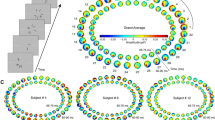Abstract
The importance of stimulus qualities such as orientation, motion and luminance in blindsight are well known but their cortical basis has been much less explored. We therefore studied the performance of two blindsighted hemianopic subjects (GY and MS), in a task in which the subject had to decide in which of two adjunctive intervals a pattern of global spots moved coherently, at a variety of speeds, in the hemianopic field. Their ability was compared with that of two control subjects with normal vision. Both hemianopes performed this simple discrimination well in their blind fields but their performance was impaired by repetitive transcranial magnetic stimulation (rTMS) applied over cortical area hV5/MT+ although not, or only slightly, by stimulation over the region of V3 or the vertex. The result is a direct demonstration that area hV5/MT+ is necessary for global motion detection in blindsight.

Similar content being viewed by others
References
Azzopardi P, Cowey A (2001) Motion discrimination in cortically blind patients. Brain 124:30–46
Barbur JL, Ruddock KH, Waterfield VA (1980) Human visual responses in the absence of the geniculo-calcarine projection. Brain 103:905–928
Barbur JL, Watson JD, Frackowiak RSJ, Zeki S (1993) Conscious visual perception without V1. Brain 116:1293–1302
Baseler HA, Morland AB, Wandell BA (1999) Topographic organization of human visual areas in the absence of input from the primary cortex. J Neurosci 19:2619–2627
Berlucchi G (2004) Some effects of cortical and callosal damage on conscious and unconscious processing of visual information and other sensory inputs. In: Heywood CA, Milner AD, Blakemore C (eds) The roots of visual awareness. Elsevier, Amsterdam
Brent PJ, Kennard C, Ruddock KH (1994) Residual colour vision in a human hemianope: spectral responses and colour discrimination. Proc Roy Soc Lond B 256:215–219
Bridge H, Thomas O, Jbabdi S, Cowey A (2008) Changes in connectivity after visual cortical brain damage underlie altered visual function. Brain 131:1433–1444
Cowey A, Stoerig P (1991) The neurobiology of blindsight. Trends in Neurosci 14:140–145
Cowey A, Walsh V (2000) Magnetically induced phosphenes in sighted, blind and blindsighted observers. Neuroreport 11(14):3269–3273
Cowey A, Weiskrantz L (1963) A perimetric study of visual field defects in monkeys. Quart J exp Psychol 15:91–115
Cowey A, Campana G, Walsh V, Vaina LM (2006) The role of human extra-striate visual areas V5/MT and V2/V3 in the perception of the direction of global motion: a transcranial magnetic stimulation study. Exp Brain Res 171:558–562
Dupont P, Orban GA, De Bruyn B, Verbruggen A, Mortelmans L (1994) Many areas in the human brain respond to visual motion. J Neurophysiol 72(3):1420–1424
Goebel R, Muckli L, Zanella FE, Singer W, Stoerig P (2001) Sustained extrastriate cortical activation without visual awareness revealed by fMRI studies of hemianopic patients. Vision Res 41:1459–1474
Goodale MA, Milner AD (1992) Separate visual pathways for perception and action. Trends Neurosci 15:20–25
Goodale MA, Milner AD (2005) Sight unseen: an exploration of conscious and unconscious vision. Oxford University Press, Oxford
Heywood CA, Cowey A (2003) Colour vision and its disturbances after cortical lesions. In: Fahle M, Greenlee M (eds) The neuropsychology of vision. Oxford University Press, Oxford, pp 259–281
Mckeefry DJ, Watson JDG, Frackowiak RSJ, Kong K, Zeki S (1997) The activity in human areas V1/V2, V3, and V5 during the perception of coherent and incoherent motion. Neuroimage 5:1–12
Milner AD, Goodale MA (1995) The visual brain in action. Oxford University Press, Oxford
Milner AD, Goodale MA (2008) Two visual systems reviewed. Neuropsychologia 46:774–785
Rodman HR, Gross CG, Albright TD (1989) Afferent basis of visual response properties in area MT of the macaque: I. Effects of striate cortex removal. J Neurosci 9:2033–2050
Rodman HR, Gross CG, Albright TD (1990) Afferent basis of visual response properties in area MT of the macaque: II Effects of superior colliculus removal. J Neurosci 10:1154–1164
Stoerig P (2006) Blindsight, conscious vision, and the role of primary visual cortex. Prog Brain Res 155:217–234
Stoerig P, Cowey A (1997) Blindsight in man and monkey. Brain 120:535–559
Sunaert S, Van Hecke P, Marchal G, Orban GA (1999) Motion-responsive regions of the human brain. Exp Brain Res 127:355–370
Weiskrantz L (1998) Consciousness and commentaries. In: Hameroff SR, Kaszniak AW, Scott AC (eds) Towards a science of consciousness, MIT Press, Cambridge, MA, pp 371–377
Weiskrantz L, Warrington EK, Sanders MD, Marshall J (1974) Visual capacity in the hemianopic field following a restricted occipital ablation. Brain 97:709–728
Zeki S, Ffytche DH (1998) The Riddoch syndrome: insights into the neurobiology of conscious vision. Brain 121:25–45
Acknowledgments
This research was supported by a UK Medical Research Council grant to AC and an EPA Cephalosporin Trust Award to IA. We thank Paul Azzopardi for the stimulus software.
Author information
Authors and Affiliations
Corresponding author
Rights and permissions
About this article
Cite this article
Alexander, I., Cowey, A. The cortical basis of global motion detection in blindsight. Exp Brain Res 192, 407–411 (2009). https://doi.org/10.1007/s00221-008-1508-4
Received:
Accepted:
Published:
Issue Date:
DOI: https://doi.org/10.1007/s00221-008-1508-4




